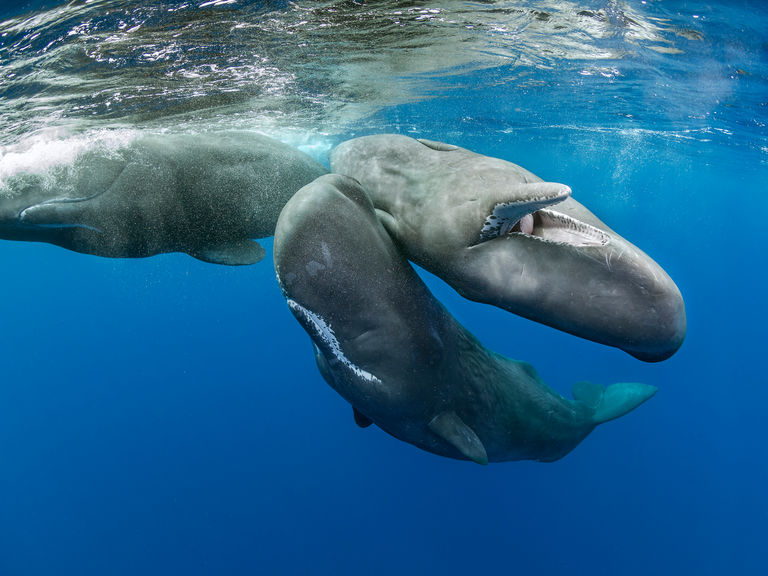Project Detail: Sperm whales of the Caribbean Sea
Contest:
Wildlife and Nature 2020
Brand:
LuganoPhotoDays
Author:
Franco Banfi
Status:
Finalist
Project Info
Sperm whales of the Caribbean Sea
It is known that spermwhales of the Caribbean Sea recognize each other and form so-called “pods” (or families), groups with complex social structure, different behaviours, in which each individual plays a role. They form lifelong relationships, starting from babysit for each other, to learn a communal dialect (the so called “codas”) and distinctive behaviours passed on by matrilinear grandmothers. In the Caribbean, the groups are composed mostly by females with their dependent calves, and juveniles.
Pic n°1-2
I was quite surprised by the number of individuals sperm-whales being part of this large group and excited to swim closed to so many animals. After a while I realized that the unusual amount of whales had a reason : I was witnessing an attempt to mate and socialize , it was not a single “pod”. In the top right corner of the second picture we can see two males (juvenile) with their penis partially everted and a huge bull male on the top left corner. At the bottom left corner of the picture there is a mature female swimming on her back, escorted by juvenile females and males.
Pic n°3
The sperm whale's eye does not differ greatly from those of other toothed whales except in size. It is the largest among the toothed whales, weighing about 170 g. It is overall ellipsoid in shape, compressed along the visual axis, measuring about 7×7×3 cm. Like other toothed whales, the sperm whale can retract and protrude its eyes, thanks to a 2-cm-thick retractor muscle attached around the eye at the equator, but are unable to roll the eyes in their sockets.
Pic n°4
When I first saw the behaviour on this picture I wrongly thought the juvenile male on the left were having an aggressive attitude and chasing the baby in the centre of the image. This revealed to be totally wrong.
As the action went forward, I learned that the only gentle way the juvenile had to separate the newborn from the mother (on the background) , was to gently move the little body with its mouth. Every other contact with its massive body against the little calf, would have ended very bad for the latter.
Pic n°5
A female sperm-whale is clearly recognizable by the rounded shape of the upper zone of the head. In the picture we see a juvenile, since the teeth in the lower jaw have just broken the white skin of the mouth.
They only have one set of teeth, on the lower jaw, with corresponding holes set in their upper gums to receive them, creating a completely sealed mouth when closed. Perfect for tearing apart their slick and cartilaginous prey (mostly squids), nothing caught in those jaws could ever escape.
I like very much this picture since I was able to catch the moment this juvenile turned towards me with her mouth wide open as if to talk to me. It seemed she wanted to communicate a strong message.
Pic n°6
In the picture we see a group of juvenile sperm-whales, socializing in shallow water, close to the surface of the sea. Staying together, touching and petting each other, they form strong bonds, lasting for the entire life.
The almost flat surface of the Caribbean Sea mirrors the grey skin of their bodies, adding an intriguing background at the image.
Pic n°7
This picture is one of the few images showing a group of sperm-whales sleeping.
I feel very lucky to have witnessed this event, since it is rare to spot the moment when a group of whales fell asleep in the middle of the ocean. From the surface we did not see any sign : the surface of the sea was flat, impenetrable, no-one shadows, whaves or signs can predict this behaviour.
Pic n°8
Sperm whale are often seen to swim on their back. This is due because their powerful sonar is located on the front upper side of the huge head. Hence, when they scan the imperscrutable column blue water in search of food or looking for finding deeper water, they need to swim upside down.
To make its clicking sounds, a sperm whale forces air through the right nasal passage to the monkey lips, which clap shut. The resulting click! bounces off one air-filled sac and travels back through the spermaceti organ to another sac nestled against the skull. From there, the click is sent forward, through the junk, and amplified out into the watery world. Sperm whales may be able to manipulate the shape of both the spermaceti organ and the junk, possibly allowing them to aim their clicks. The substance that made them so valuable to whalers is now understood to play an important role in communication.
In addition to echolocation, in social situations, sperm whales produce repeated patterns of clicks called codas, which are used to attract females, compete for mates, display aggression, and maintain group cohesion. While foraging, sperm whales generally make regularly spaced clicks interrupted by “creaks”, and very rapid clicking associated with short range sonar and the last stages of prey capture.
Pic n°9
In the picture we see an adult sperm-whale female and her young baby. Mothers and calves form strong relations, even though the baby calves are raised with the help of “baby-sitters”, which often are sisters of the mother or younger sisters of the calf.
In the Caribbean, the females remain all life within the mother’s group, while the males leave the unit in their early teens and have solidary lives, roaming the open oceans, mostly alone, venturing up north and south to the higher latitude and colder water.
Pic n°10
The powerful tail of sperm whales is called fluke. For the researchers, tails are like the fingerprint, since they are able to identify many individuals by the unique marks of their tails. The marks are what remains from the bites of predators (mostly pilot whales and killer whales), which often snap on the flesh of baby and juvenile sperm-whales. By observing the unique marks of the tails, researchers are able to track individual whales with the help of data and images collected by the whales’ watchers operators.
Due to its unique mark, the female shown in this pictures was named “can-opener”
Sperm whales sleep vertically, head toward the surface and flukes below. They stayed still in this upright drifting posture for about 10 to 15 minutes at a time, and did not breathe or moved at all during their naps.
Pic n°11
The sight of whales lifting the tail and repeatedly slap on the surface of the sea is a true spectacle, but the animals don’t do it just for show. Instead, it appears that all that splashing is about messaging other whales, and the big splashes are for long-distance calls.
There was a sudden increase in this behaviour just before new whales joined or the group split up.
Species : Sperm whales (Physeter macrocephalus)
Location : Caribbean Sea, off the coast of Dominica Island, part of the Windward Islands chain in the Lesser Antilles archipelago
Conservation status (IUCN) : Endangered
Picture taken under licence from the Ministry of Agriculture, Fisheries division

















